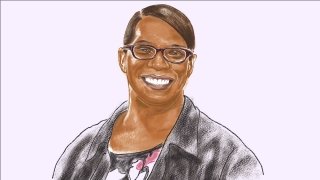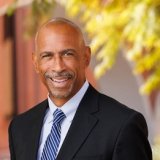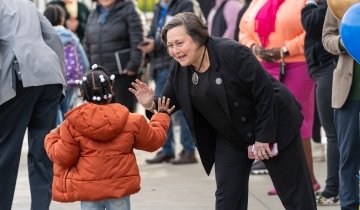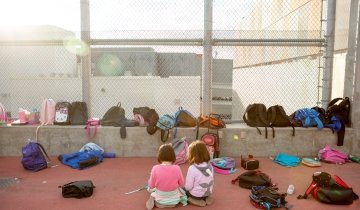You grew up in Pacoima in the San Fernando Valley region of Los Angeles. How did that shape you?
Pacoima is a community where everyone knows everyone. As a result of housing covenants, it was the only place in the San Fernando Valley where Black people could live. It is located on Indigenous land, so there are Indigenous peoples who originated in Pacoima and still live there. Pacoima became this area of immense diversity because of the racist housing policies—[home to] Latinos, Filipinos, Japanese Americans and Indigenous folks.
My grandmother, Toy Dula Knight, was a member of the NAACP and was very active in the civil rights movement and in the community. Before she relocated to L.A., she was a one-room school teacher in North Carolina and served in the Black Women’s Army Corp in World War 2. After earning her California teaching credential, she was—for years—unable to secure a permanent teaching position for LAUSD because of her Southern accent. For most of her teaching career, she was a substitute, eventually landing a permanent job at Filmore Elementary in Pacoima. But she taught so many people in the community. I was in elementary school when she started showing signs of Alzheimer’s. I missed out on a lot of time with her, but a lot of people say that I have carried on her legacy. My grandmother’s activism and my involvement in the Black church were instrumental for me.
Much of my youth was spent in the Black church in Pacoima. The Black churches would come together to celebrate Black history, leaders and community service, providing a lot of opportunities for young people to give speeches and take leadership positions.
When I was in junior high in 1992, the Rodney King beating occurred in the neighborhood next to Pacoima. He was beaten right there on the corner of Foothill Boulevard. We could hear the helicopters and the chase from the 118 freeway. For those of us in Pacoima, it had such an impact on our lives, especially as young people. I was at school when the riots broke out, and we could see the glow of the fires. There was a lot of rioting, protest and looting in Pacoima. My first in-your-face racist experience happened around the same time when I was in seventh grade at a store with my mom, but to see such violence and the blatant privilege the officers had through the justice system, that really shaped a lot of my ideology and thoughts about race and activism, and our status in our community and in the world.
After the riots, there were a lot of efforts to rebuild the community and build relationships between different racial groups. At San Fernando High School, I was encouraged to be involved in a lot of things. At the time, I thought I was their token Black girl who they could send to different events. I hated it, but when I look back, I know I needed those [experiences] to become who I am today. I went to Girls State, and soon after that, I was invited to apply to Occidental College’s Multicultural Summer Institute (MSI). The goal [of the program] was to take urban youth of color to Oxy. It was like a mini college experience, and there was a lot of cross-racial and dialogue training. I thought Oxy was the most beautiful campus I’d ever seen.
One of the recruiters who came to San Fernando to tell the students about MSI came back during college recruiting time, and he sought me out to recruit me to go to Oxy and apply for the James Irvine scholarship. The scholarship was specifically designed for students of color from the L.A. area and rural areas. We had to have pretty good grades, but the [most important criterion] was that we were leaders and active in our community. It was a very rigorous process, formal and highly competitive. I was blessed to become one of the Irvine scholars.
"My grandmother’s activism and my involvement in the Black church were instrumental for me." —Akilah Lyons-Moore EdD ’14
You completed your bachelor’s in public policy at Occidental College, and you were involved with on-campus actions urging the school to hold up its promises of diversity and inclusion. Could you tell me a little bit about that?
When I first arrived at Oxy, I was like, ‘Oh my gosh, what did I do?’ The school was about 99 percent White and 1 percent everybody else. In my first year, there were 100 Black students out of 1,600 total students. We didn’t even know who the 100 Black students were because not everyone identified or presented themselves as Black. I had a serious culture shock, and I had a serious—I don’t even if this is a term—academic shock. Even though I could be in the top tier of the class at San Fernando, I felt I didn’t know anything compared with the academic standards at Oxy. It was very difficult for me, but I was determined to finish college. I didn’t want to leave because I had an amazing scholarship that afforded me opportunities to intern at community organizations every summer. And they had wonderful faculty—faculty of color—that were very caring.
However, the students of color were also experiencing a lot of blatant racism. I became involved in the Black Student Union my first year, and I eventually became president of the BSU. I also connected with—I think they would identify as—Chicano and Chicana students, and we clicked. We were so like-minded on this issue of multiculturalism, and we were proud of our racial backgrounds. We felt that we were constantly being questioned and our presence was being questioned. There was a group of us who became activists, and we planned various disruptions.
This is in the aftermath of Rodney King, so there was a lot of discussion about what happened during that incident. We had students writing opinion pieces in the school newspaper saying that the police are justified in beating Black men because they have a “natural athletic prowess.” So I wrote some pieces, too, and there was a lot of back-and-forth. The group I was working with decided to take some actions. Every year, we did something around the International Day Against Police Brutality. One year, we went out in the middle of the night and chalked body outlines all over campus, and [inside the outlines] we wrote a name and date of a person who was killed by police. When people walked around campus the next day, many of them were really upset. So, we became “the radicals.”
At Oxy, just as at USC, students call alumni for donations. A lot of the students calling alumni were Black and Brown students, and the alumni on the other end of the call, perhaps not even knowing who they were speaking to, said things like, “I’m never sending money to this school again because they have all those little people of color.” They were afraid the school would admit too many students of color, and it wouldn’t be the same. And we also had a Black president at the time, John Brooks Slaughter [current professor of education at USC Rossier and of engineering at USC Viterbi].
Our student-body president was able to meet with President Slaughter and the deans. We learned that as a result of the dip in contributions by alumni, the school was going to roll back its affirmative action program. At this point, we had a much larger group who began meeting in our dorms, talking about the issue. We were able to project that, eventually, Oxy would get to a point to where it was, once again, practically an all-White school. We were all there as a result of their focus on multiculturalism and their explicit recruitment of a diverse student body. So that’s when a lot of the other major actions began.
We put up flyers projecting the decline in enrollment of students of color, and we had debates in the quad. Our student government president met with Dr. Slaughter several times, and there was a small group of us on an organizing committee who also met with him. We were beginning to plan a pretty radical action, and Dr. Slaughter recommended that we not go the route we were planning. He told us that there were other ways we could approach this problem. He was definitely our ally, but we were so impatient, like the young people involved in the civil rights movement who did not listen to the folks in the NAACP. So we decided to take over the administration building and demand to speak with some of the members of the Board of Trustees. They refused to meet with us, but we said we wouldn’t leave until they did. Dr. Slaughter was amazing. I remember him coming out and talking to us. I don’t remember how many days we stayed there, but we were prepared to stay overnight, and we did. Some of our professors brought us food. The news came out, and we made our voices heard.
Oxy was fundamental for me in terms of my thoughts around activism and my experience at a predominately White school. I also had the opportunity to work with the most amazing nonprofit, grassroots organizations. It shaped my beliefs and my understanding about ways that young people can be active, more strategic and purposeful.
You were once a high school history and social science teacher. What do you miss about teaching high school?
I loved my students, being able to talk with them, teach them, collaborate, build relationships, and see their growth. I taught 11th and 12th grade, and I was their adviser for the Black Student Union, so I knew a lot of students before they got to me. I miss opening a world to students that they didn’t know existed. I taught history from a different perspective than most of my colleagues. For a lot of my students, I was their first Black teacher.
You completed your Master of Arts in Teaching at USC Rossier and then came back for your EdD. What made you return?
The MAT completely changed the way I teach. I learned how to be much more strategic and purposeful. I also learned about my own movements in the classroom and my own implicit bias. I also was working at the district level to help bring culture responsiveness to the district. I was running up against a lot of resistance, and so I thought that the Doctor of Education in Educational Leadership program would equip me with additional skills to navigate and maneuver that. It’s probably one of the best decisions I made. I was a mom and pregnant with my youngest when I started the program. I was so nervous, but everyone was so supportive. I found a mentor, Dr. Julie Slayton, who was my dissertation chair. Between my finishing the dissertation, teaching and being an administrator, she was always there. The faculty here are just exceptional. That’s why I came back.
Tell me about your role with Civics & Civility: The Democracy Project, USC Rossier’s new civics education initiative.
Dean Pedro A. Noguera asked me and Dr. Jenifer Crawford if we would be interested in helping to shape a new initiative around improving civics education. Coming together—being able to talk and hear each other—is necessary, especially in our current context. And yet, it is not taught in K–12 civics education.
Dr. Robert Filback, Dr. Crawford and I are co-chairing the committee to get the project up and going. I’m so excited to be a part of this and to rethink how civics education is taught.
What are some preliminary findings?
As we researched civics-education curriculums, we found that current practices are all about memorization. There is a gap between the need to actually engage students in civic-minded activities and learning experiences. So, we’re really thinking about how to utilize the voices of young people and their forms of activism, within what is traditionally called civics education. I look at everything happening today, and there is a lack of understanding around free speech, our amendments and the Bill of Rights. There is also a significant lack of ability to parse through discourse and identify what is truth, data and facts, and what are political arguments.
I think about the people who claimed that the election was stolen and what happened at the Capitol, and the first thing I think about is our students. How can we teach to this moment, in order to truly prepare civic-minded students who can have political or ideological disagreements? How do we help them debate their own perspectives and use evidence? At the same time, how can we help them to talk to each other with respect, with empathy, with an understanding that there are a lot of people in this country who are marginalized and have been historically, because it was written within the founding documents of our country?
What is education’s role in ensuring the health of our democracy?
Education’s role is to equip young people with the skills they need to participate in democracy. Instead of focusing on these skills, there’s too much focus on the content—and the content is biased. If we focus on, for example, reading and literacy, and think about perspective and how it changes over time, we can equip students to read original documents and help them to unpack the meaning in them.
One of the most important things is to equip young people with civic-minded skills and [an understanding of] the history of the country. I’m a community organizer at heart, so I think about how our young people can consider these issues in the context of their own communities, bridging civics education with civic engagement. Our goal is to create a whole generation of young people who are civically engaged.
"I think about the people who claimed that the election was stolen and what happened at the Capitol, and the first thing I think about is our students. How can we teach to this moment, in order to truly prepare civic-minded students who can have political or ideological disagreements?" —Akilah Lyons-Moore EdD ’14
What are some of the unique challenges that government and civics teachers face?
One difficulty is the polarization of the country, and how to teach young people who are coming to the classroom with opinions that may be shaped by their parents’ opinions. Many teachers may have difficulties talking about what’s happening in our country because of that polarization and an assumption that they are tied to a particular side of the debate.
Many government and civics teachers may not see a role for talking about current events, and they just want to teach what’s in the Constitution. You have to be strategic and purposeful with how you do it. You have to know your students enough to anticipate what some of their thoughts may be. History and civics teachers must be equipped with not just the knowledge but also the courage to speak to students about misconceptions. But you can’t just tell students. You have to engage them in some kind of experience to show them. Teachers have to give students the opportunity to construct this knowledge for themselves, with their peers. The difficult part is creating that experience.
Do you have any advice for how teachers who don’t teach government or civics can promote civil discourse in their classes?
It’s about knowing what civics means and identifying the skills of civics. Let’s say I have elementary students. Students could draw pictures of what they’ve seen on the news—I wouldn’t do this until maybe second semester—but you could have them draw a picture to express how they feel about what’s going on. If it is done strategically, you will be able to draw out different understandings and feelings, and be able to identify the differences, acknowledge and appreciate them.
It could be teaching students how to debate, how to create a logical argument with evidence. I think that every subject, at every grade level, has a role in fostering civic-mindedness. It [can be modeled] on how things are done in the classroom, how mistakes are acknowledged, corrected and are OK. We can repair some harm that was caused with a student interaction or an argument that happened in class. It’s not shying away from those opportunities; it’s embedding them. A good idea would be to list [the qualities] of what it means to be a citizen in class, and what it means to be a citizen in your community. Once we take our students’ understandings and how they conceptualize these things, it can form the basis of our class community, so they are experiencing a civic-minded classroom.
"Our goal is to create a whole generation of young people who are civically engaged." —Akilah Lyons-Moore EdD ’14
What impact can training teachers to be better equipped to teach and discuss issues of civic engagement and democracy have on historically marginalized students in particular?
That’s a concept we’re talking about in The Democracy Project working group: What does civics education mean for our Latinx students, students who identify as LGBTQ, and Black students? [These students] oftentimes have been left out of the civics-education experience, but these communities are often impacted greatly by what happens in our democracy. [Civics education] can help them understand the why and consider how to make changes.
One thing that is rarely taught in history classes is the role of youth and community organizers in the expansion of democracy through voting rights. One of my heroes is Ella Baker; she was the adult behind the scenes [of the Student Nonviolent Coordinating Committee] helping young people organize, train, strategize and do the work of registering Black voters in the deep South. There are some things that communities of color have done historically, that have contributed to our democracy in fundamental ways, that are not acknowledged.
Civics education has the potential to [help these] young people know that they come from a legacy of people who have changed our democracy for the better. The Democracy Project has the potential to help transform communities. Not according to our ideas, but according to the ideas of the community.









